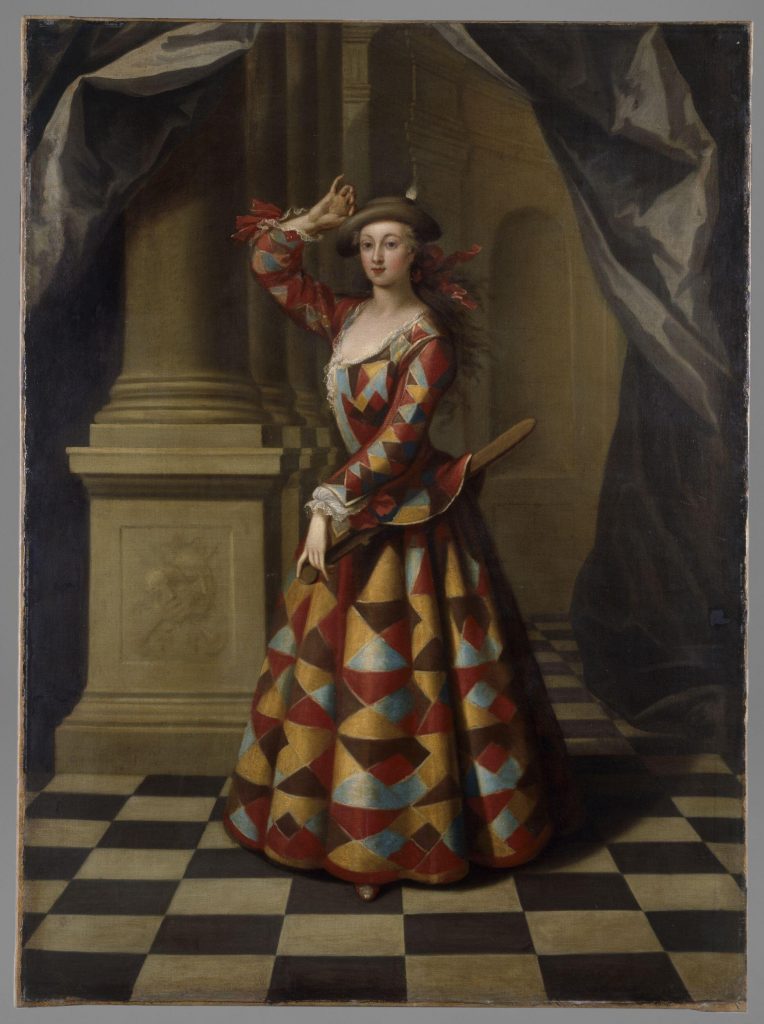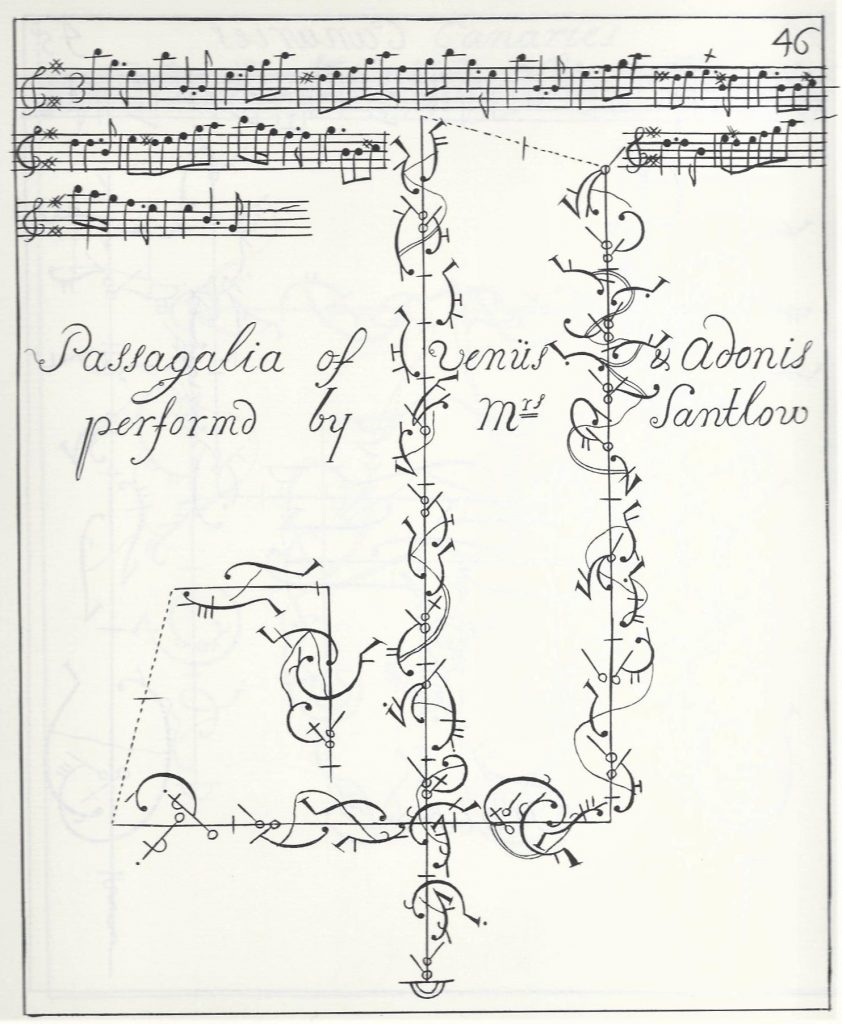MOIRA GOFF
On 2 March 1717, The Loves of Mars and Venus a ‘Dramatick Entertainment of Dancing’ by John Weaver was given its first performance at Drury Lane. The new afterpiece was innovative and even experimental, for it told the story of the love affair between Mars and Venus and the revenge taken by Venus’s husband Vulcan using only dance and mime, with no spoken or sung words to explain the plot or the action. Weaver himself was Vulcan, with the dancer Louis Dupré as Mars and the dancer-actress Hester Santlow (1693 or 1694 -1773) as Venus. In his scenario, published to accompany performances of the entertainment, Weaver acknowledged ‘I have not been able to get all my Dancers equal to the Design’.[1] The one performer in Weaver’s cast who was undoubtedly equal to his demands was Hester Santlow. She would continue to play Venus in revivals of the afterpiece until 1724 and she would take leading roles in both of his subsequent ‘Dramatick Entertainments’, as Eurydice in Orpheus and Eurydice in 1718 and Helen of Troy in The Judgment of Paris in 1733. Mrs Santlow seems to have been central to John Weaver’s attempts to reform stage dancing in London.
In An Essay towards an History of Dancing, published in 1712, John Weaver devoted his final chapter to ‘Modern Dancing’. He provided his own analysis of genres of stage dancing, proposing the reform of English theatrical dance by adopting what he called ‘Scenical Dancing’. He described his new genre thus:
Scenical Dancing, is a faint Imitation of the Roman Pantomimes, and differs only from the Grotesque, in that the last only represents Persons, Passions, and Manners; and the former explains whole Stories by Action.
According to Weaver, ‘Grotesque Dancing’ was ‘wholly calculated for the Stage and takes in the greatest Part of Opera-Dancing’. He linked grotesque dancing to the principal characters of the commedia dell’arte, referring to their performers as ‘modern Mimes inimitable’. Weaver also mentioned ‘Serious Dancing’, which he defined in terms of skill rather than the expression he saw as integral to the other two genres.[2]
Hester Santlow had begun her career as a dancer at Drury Lane in 1706, making her debut as an actress at the same theatre in 1709. By the 1716-1717 season, she was both a leading dancer and a leading actress with the company and able to draw on a repertoire of more than twenty-five dramatic roles as well as a range of both serious and grotesque entr’acte dances.[3] Mrs Santlow’s most popular entr’acte dance was a solo Harlequine and there are many depictions of her as this character, the best-known of which is now among the theatre collections in the Victoria and Albert Museum.

Hester Santlow as Harlequin, by John Elys, ©Victoria & Albert Museum
We have no corresponding portrait of her as a serious dancer, although some of the choreographies that she performed were recorded and published in Beauchamp-Feuillet notation. These give us an idea of the professional dance skills that Hester Santlow brought to the role of Venus in Weaver’s ballet. As an actress, Mrs Santlow would have had a variety of expressive gestures at her command. She had all the performance skills needed to excel in Weaver’s Scenical Dancing.
Weaver’s afterpiece has six scenes. Venus first appears in scene two:
After a Simphony of Flutes, &c. the Scene opens and discovers Venus in her Dressing-Room at her Toilet, attended by the Graces, who are employ’d in dressing her. Cupid lies at her Feet, and one of the Hours waits by. Venus rises, and dances a Passacaile: The Graces joyn her in the same Movement, as does also the Hour.[4]
The scenery, from the theatre’s existing stock, may have placed Venus in a setting more suited to the heroine of a Restoration comedy than the goddess of love, but her passacaille must have been intended to evoke the sophistication and grandeur of French opera. Hester Santlow’s repertoire as a dancer-actress had made her familiar with both.
No music (with the possible exception of one tune) and no choreography for The Loves of Mars and Venus are known to survive, so we must look to other sources to envisage Weaver’s new afterpiece.[5] He later ascribed the music for The Loves of Mars and Venus to Henry Symonds and Charles Fairbank, with Fairbank (who was also a dancer) responsible for the ‘musical Airs of the Dancing Parts’.[6] It is possible, if not likely, that Fairbank made arrangements of existing music as well as supplying new compositions of his own. He might well have turned to a French passacaille as a dance already familiar to London audiences.
Although she is not billed as dancing a passacaille until 5 April 1720 (when she performed a solo for John Weaver’s benefit), Hester Santlow had become familiar with the form as early as 1706, when she danced a duet with Mrs Elford choreographed by Anthony L’Abbé to the passacaille from Lully’s opera Armide. L’Abbé later created a solo for her to the passacaille from Desmaret’s opera Vénus & Adonis, which she may have performed around the time of The Loves of Mars and Venus.[7] L’Abbé’s choreography hints at dancing expressive of ‘Persons, Passions, and Manners’ as well as exploiting Mrs Santlow’s technical skills. It reveals the qualities she would have brought to her performance as Venus in Weaver’s ballet and provides clues to the choreography she performed in scene two.[8]

Anthony L’Abbé, Plate one, ‘Passagalia of Venüs & Adonis’
Venus has two more dances in Weaver’s ballet, an Entry in scene four and a final Grand Dance in scene six. Scene four is set in ‘A Garden’, although Weaver characterises the action as ‘alternate, as representing Love and War’. The Entry is begun by the four Followers of Mars, who are joined by the Graces (and presumably the Hour as well) and then by Mars and Venus. Although Weaver prescribes no specific gestures, he obviously saw this dance as expressive, for he describes how ‘the Fire, Robustness; and Strength of the Warrior is seen mixt with the Softness and Delicacy of Love’ adding that the dance concludes ‘with every Man carrying off his Woman’. It may have been a suite of dances, beginning with the Followers of Mars and culminating in a duet between Mars and Venus before finishing with all ten dancers together. Hester Santlow and Louis Dupré had been the lead couple in the group dance Myrtillo, first given at Drury Lane on 14 October 1715 within the afterpiece Myrtillo and Laura but soon performed separately in the entr’actes. The surviving music for this dance is a suite.[9] Since at least six of the ten dancers in the Entry in scene four of The Loves of Mars and Venus also danced in Myrtillo, there is the possibility of a connection between the two.
The Grand Dance which ends The Loves of Mars and Venus is performed by ‘Mars, with the rest of the Gods, and Goddesses’.[10] Weaver leaves us to infer that this is a piece of serious dancing, symbolising the restoration of harmony between the deities after Vulcan has forgiven Mars and Venus. Such Grand Dances already had a long history on the London stage, with notable examples in the dramatic operas of Henry Purcell (which Weaver is likely to have known). There were nine performers in his Grand Dance, suggesting that Mars, Vulcan and Venus may have danced singly and together, with the other deities forming a corps de ballet. Mars and Venus, if not Vulcan, will surely have provided a display of French serious dancing for the stage.
The Loves of Mars and Venus was performed forty-four times between 1717 and 1724. The dancers who performed Mars and even Vulcan (Weaver’s role) changed over that period, but Hester Santlow retained the role of Venus. She went on to take the leading female roles in Weaver’s subsequent dramatic entertainments of dancing, showing his dependence on her skills as both a dancer and an actress.
Other dancing masters at Drury Lane acknowledged her mastery by casting her in leading roles within new afterpieces which tried to emulate Weaver’s. She was Daphne in John Thurmond Junior’s Apollo and Daphne; or, Harlequin’s Metamorphoses, given on 20 February 1725, and Andromeda in Roger and Weaver’s Perseus and Andromeda: With the Rape of Colombine; or, The Flying Lovers, given on 15 November 1728. Roger choreographed the serious part of Perseus and Andromedaand later cast Hester Santlow as Diana in a pantomime afterpiece, Diana and Acteon, which he created for his own benefit performance on 23 April 1730. It is possible to see her dance-drama skills being deployed in two of the entr’acte dances she performed with her last dancing partner George Desnoyer, the Grand Ballad d’Amour and Le Chasseur Royal given during the 1731-1732 season.[11]
John Weaver visited and worked in London intermittently after 1712. Scenical dancing was used and developed in Drury Lane’s afterpieces and entr’acte dances by Hester Santlow, and her performances influenced dancing at Lincoln’s Inn Fields and elsewhere. As the leading dancer and a leading actress at Drury Lane for more than twenty years she ensured the ultimate success of Weaver’s reforms in London’s theatres.
Notes
[1] John Weaver, The Loves of Mars and Venus (London, 1717), p. x. All of Weaver’s published works are reproduced in facsimile in Richard Ralph, The Life and Works of John Weaver (London, 1985), to which references will also be given. For this quotation see p. 739.
[2] John Weaver, An Essay towards an History of Dancing (London, 1712), pp. 162, 164, 168. Ralph, John Weaver, pp. 655, 658, 665.
[3] For details of Mrs Santlow’s career, see Moira Goff, The Incomparable Hester Santlow (Aldershot, 2007).
[4] Weaver, Loves of Mars and Venus, p. 20, Ralph, John Weaver, p. 752.
[5] The country dance tune ‘Mars and Venus’ in The Dancing Master: or, Directions for Dancing Country Dances. The Third Volume (London, [1728?]), p. 31, and its possible inclusion in The Loves of Mars and Venus is discussed by George Dorris, ‘Music for the Ballets of John Weaver’, Dance Chronicle, 3.1 (1979), 46-60 (pp. 50-53). The tune is also associated with the actor Henry Norris, who may have been one of the Drury Lane ‘Comedians’ who danced the Cyclops in Weaver’s ballet in 1717.
[6] John Weaver, Anatomical and Mechanical Lectures upon Dancing (London, 1721), p. 143, also reproduced in Ralph, John Weaver, p. 1017.
[7] Goff, Hester Santlow, p. 79. For the notation, see Anthony L’Abbé, A New Collection of Dances. Originally published by F. le Roussau London c.1725, intro. Carol G. Marsh (London, 1991), pls. 46-56.
[8] Moira Goff, ‘Imitating the Passions: Reconstructing the Meanings within the Passagalia of Venüs & Adonis’, Preservation Politics: Dance Revived, Reconstructed, Remade, ed. Stephanie Jordan (London, 2000), pp. 154-165.
[9] Goff, Hester Santlow, p. 78.
[10] Weaver, Loves of Mars and Venus, p. 27. Ralph, John Weaver, p. 760.
[11] Hester Santlow’s repertoire and her contribution to dancing on the London stage is discussed in detail in Moira Goff, ‘Art and Nature Join’d: Hester Santlow and the Development of Dancing on the London Stage, 1700-1737’ (unpublished PhD Thesis, University of Kent at Canterbury, 2000).
Next Post
‘Hester Santlow “Scenical Dancing”: The Drama’, by Moira Goff, will appear on 24 November.